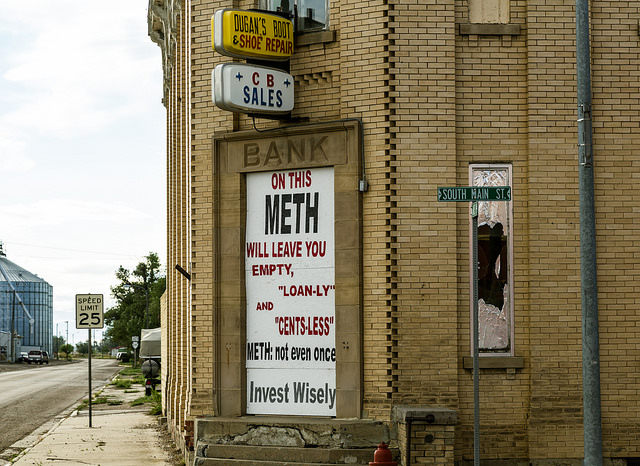For rural areas across America long under siege by the opioid epidemic, a disturbing trend has emerged: Drug users are showing up in emergency rooms with rotting teeth, emaciated bodies, and erratic, violent behavior. These are the dark signs of methamphetamine’s presence in these communities. Meth faded from public view after its peak in the early 2000s, but it has come back with a vengeance–more than 10,000 people died from methamphetamine overdoses in 2017. From places like Oklahoma to Montana, meth overdose deaths have surpassed deaths from any other drug.
Meth kills more slowly than heroin and prescription opioids. It causes long term damage to organs, rots teeth, and causes angry lesions to emerge on the skin. Hospital emergency rooms are overwhelmed; In Alaska, hospitalizations due to meth use jumped 40 percent from 2015 to 2016, costing the state millions of dollars. Adding to the issue is the fact that addicts who die from the prolonged health problems are not counted in overdose statistics, making it difficult to see how large the crisis actually is.
Meth rattles even the communities hardened by the daily horrors of the opioid epidemic. A meth high can keep a user up for days with erratic and aggressive outbursts. Consequently, as meth has resurged in rural communities, so has violent crime. According to the 2017 National Drug Threat Survey, 30 percent of local governments reported meth as the largest drug concern in their area and the biggest drain on law enforcement resources. Police officers in Vinton, Ohio, a town long at the center of the opioid crisis, report that meth has made the area more dangerous than heroin ever did. In Billings, Montana, police attribute the 85 percent spike in violent crime from 2010 to 2017 to the arrival of meth.
Although police officers are sounding the alarm, politicians seem oblivious to the growing crisis. The opioid crisis remains a high priority in political discourse, yet meth is completely ignored.
Part of the problem lies in meth’s history in the United States: In the early 2000s, exploding homemade meth labs were a regular feature on the evening news. It was a “trailer park drug,” manufactured in people’s homes with ingredients found in drugstores. The Methamphetamine Epidemic Act of 2005 sought to stem the tide of fatal overdoses and violent crime surrounding the drug by restricting access to the over-the-counter drugs used to make meth. It worked, at least initially. Overdose deaths declined in the later 2000s, and “mom and pop” kitchen meth labs all but disappeared. For politicians, the issue was solved.
But the demand for meth did not vanish alongside the political interest in the problem. Instead, new suppliers stepped up to fill the void: Southern Mexican drug cartels. These cartels produce meth on an industrial scale, and their product is strong and cheap. Nearly 100 percent pure, this meth is more deadly than before, and it is pouring across the southern border: Seizures of meth have skyrocketed more than 250 percent since 2012. After crossing the border, this meth finds its way to the heartland of Wisconsin and Montana, where users can buy it for 5 dollars a hit. With this new meth, users are dying faster and in greater numbers than ever before.
It’s no coincidence that meth is making a resurgence during the opioid epidemic. Unsurprisingly, meth and opiate abuse are linked. Trying to conceal the sedative effects of heroin and other opioids, addicts turn to meth to stay awake. Rumors have spread that meth can help with intense opioid cravings when trying to quit a heroin addiction. Instead, people trade one addiction for another–or find themselves at the mercy of both heroin and meth.
To make matters even worse, the solutions available to opioid addicts can also inadvertently encourage methamphetamine use. Vivitrol, a drug used to treat opioid addiction, blocks an opioid high, but it doesn’t block a meth high. For users in withdrawal, desperate for any kind of high, cheap meth is too hard to resist. The relationship between opioids and meth is underscored in Alaska, where nearly half of fatal overdoses from meth involved heroin or other opioids.
Meth is showing up in areas which have never before seen its effects. Once considered a “trailer park drug,” meth is taking hold in urban areas. In Portland, meth has surfaced in black neighborhoods, an unheard of problem just a few years ago. Throughout the South, meth is following heroin addicts into cities like New Orleans. Wherever heroin is, meth follows–and politicians need to pay attention to this pattern.
By ignoring the link between the resurgence of meth and the opioid crisis, politicians risk being caught unprepared to deal with the devastating impact of meth on communities. Political attention on the opioid crisis has encouraged and expedited the development of drugs like Vivitrol, methadone, and naloxone, which numb opioid cravings and revive overdose victims. Almost every state has made Naloxone more available to the public. No comparable drugs exist to treat methamphetamine addiction.
One of the only treatment options available for meth addicts is behavioral therapy, whether in residential or outpatient settings. Yet addiction treatment programs are completely overwhelmed by the opioid crisis, and therapies that work for opioid addiction may not be completely transferable to meth addiction.
The political silence surrounding meth addiction is deafening. Left unchecked, the meth crisis could easily explode in the same way opioid abuse did around 2010. Meth is intertwined with the opioid epidemic, yet it has different and dangerous implications for communities. Washington was caught unprepared for the opioid crisis, and without early action the crisis multiplied into an epidemic. The same doesn’t have to be true for the growing meth problem.
Photo: Montana Meth Sign
